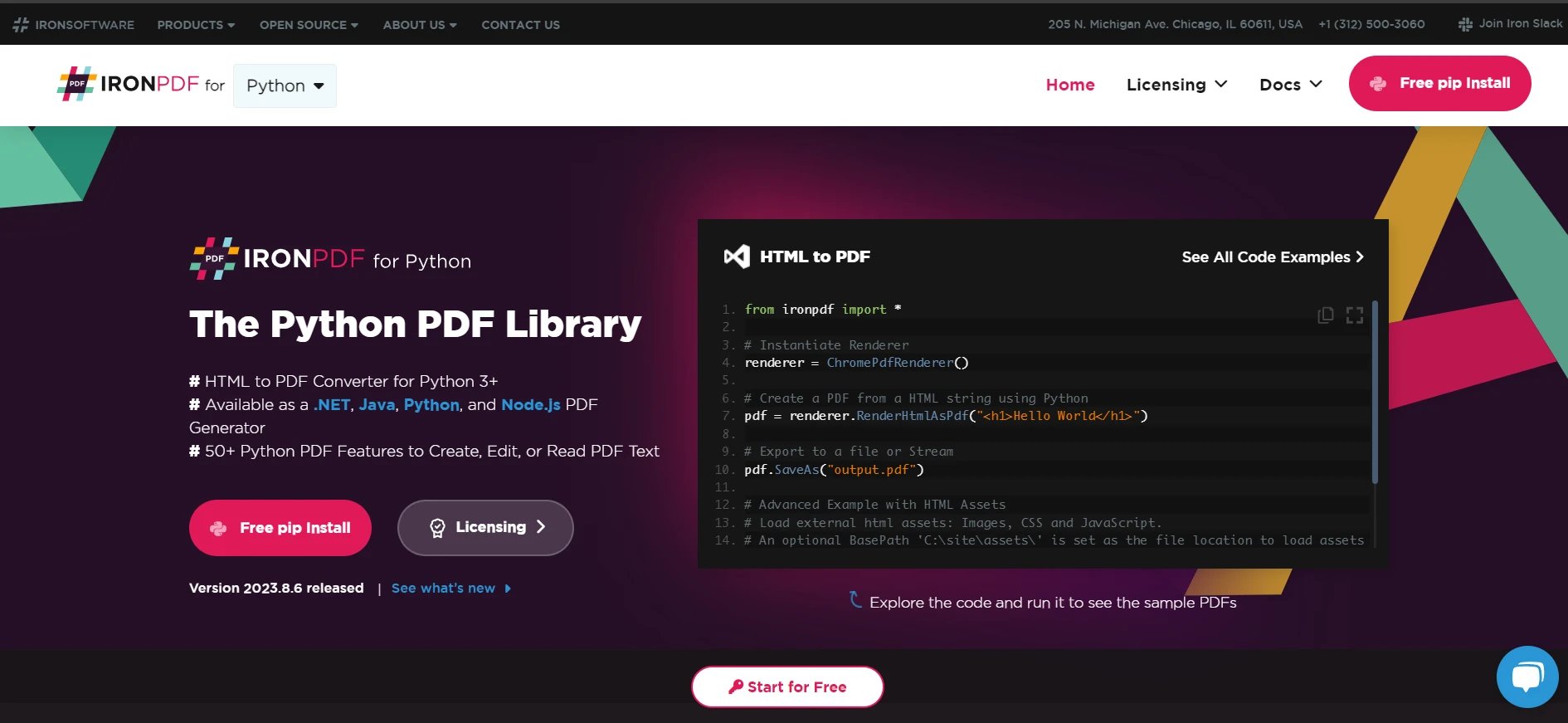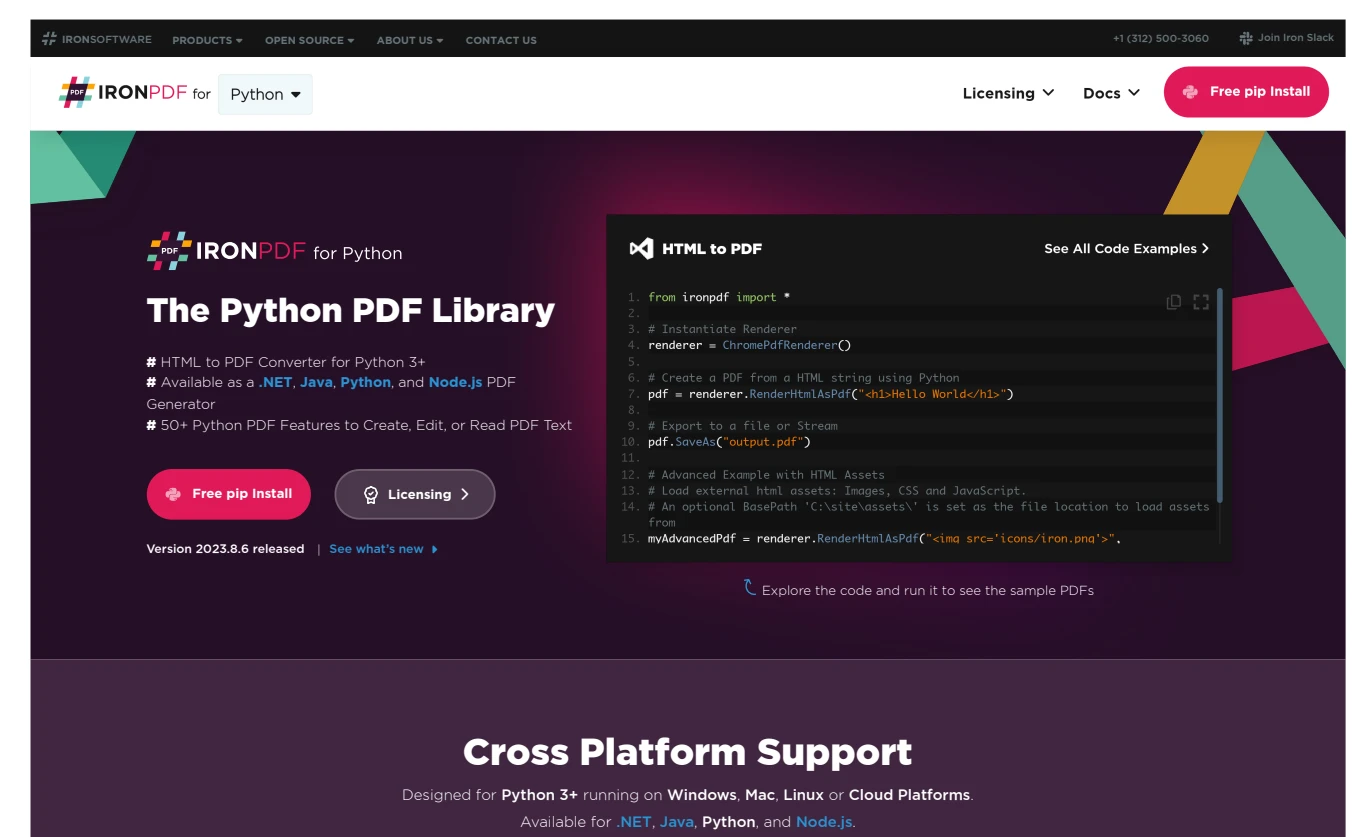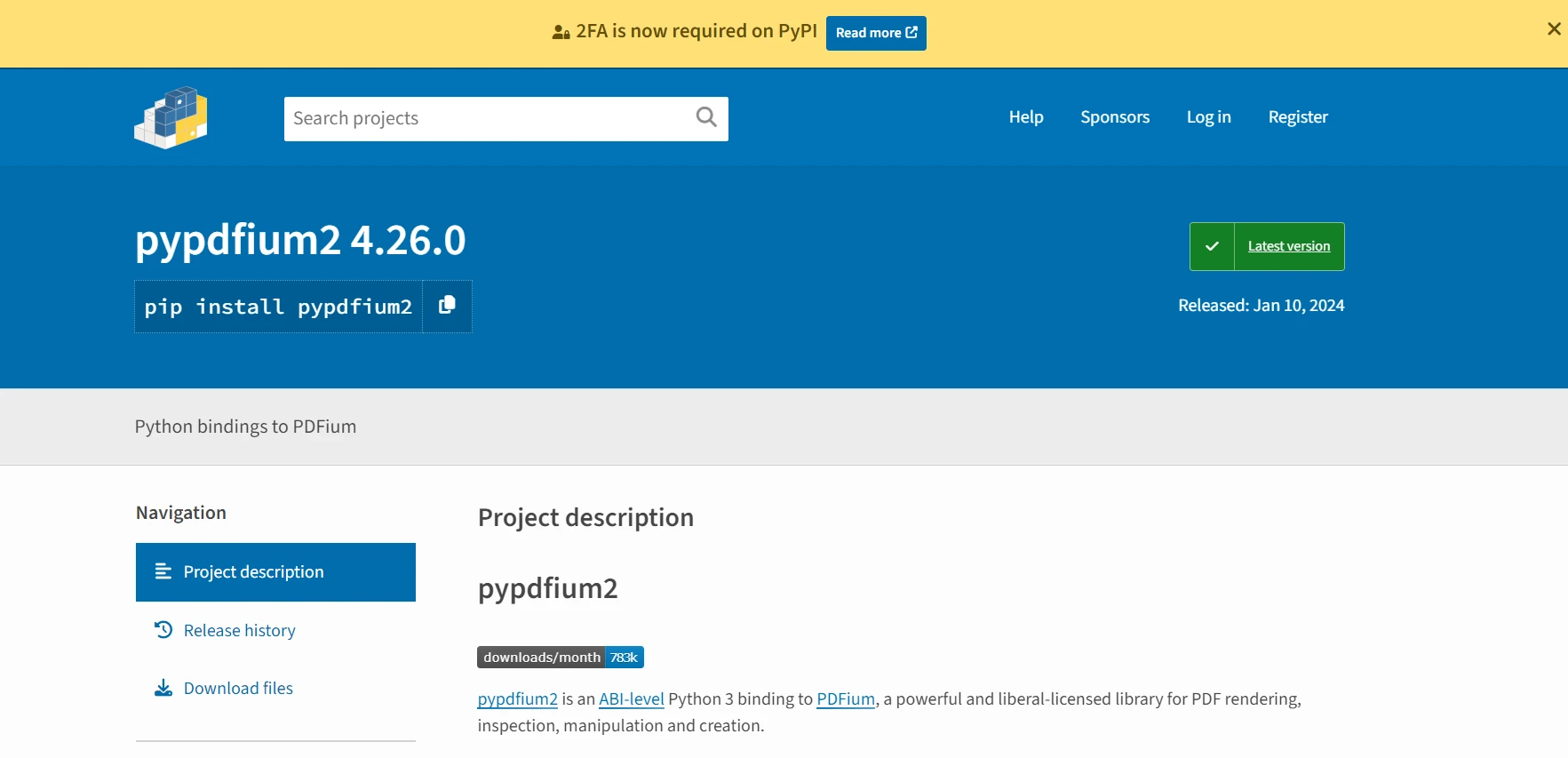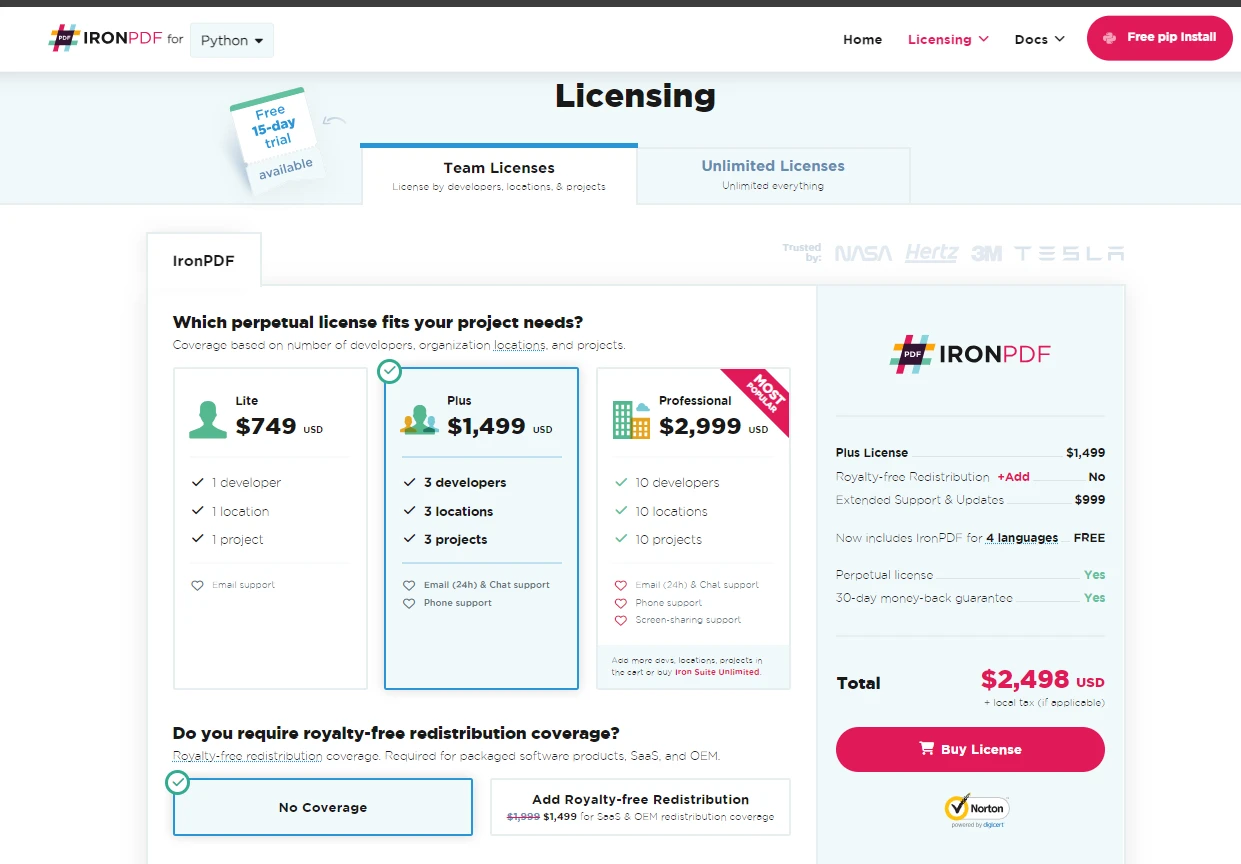Test in a live environment
Test in production without watermarks.
Works wherever you need it to.
PDFs are a universal standard for documents, and their reliability and consistency across different platforms make them a preferred choice in all fields. As such, the tools, third party components and libraries that developers use to manage PDFs can significantly influence the efficiency and effectiveness of an application.
This blog post delves into a comprehensive comparison between two prominent PDF file libraries: IronPDF Python and PDFium Python. These libraries offer developers powerful tools for creating, editing, and converting PDF page documents within their source tree applications. However, choosing the right library can often be a daunting task. Through this comparison, we aim to highlight the unique features, performance, and use-case scenarios of each PDF rendering library, providing insights that will help you make an informed decision for your development needs.

IronPDF Python is a PDF library designed for Python applications, enabling developers to create, edit, and extract content from PDF files. It offers a wide range of functionalities, including the generation of PDF documents from various sources like HTML, URLs, JavaScript, CSS, and numerous image formats. Users can also enhance their PDFs by adding elements such as headers, footers, signatures, and attachments and implementing passwords and security features. Here are the key highlights of IronPDF Python.
PDF Generation: IronPDF can generate a PDF file from various sources like HTML, URLs, JavaScript, CSS, and multiple image formats. Here is the example code:
from ironpdf import *
# Instantiate Renderer
renderer = ChromePdfRenderer()
# Create a document PDF from a URL, image or local file path
pdf = renderer.RenderUrlAsPdf("https://ironpdf.com/python/")
# Export to a file or Stream
pdf.SaveAs("url.pdf")Here are the output images:

Extensive Feature Set: IronPDF for Python provides multiple features, including the ability to add headers/footers, signatures, and attachments and implement password security to safeguard sensitive information within a PDF document.
from ironpdf import *
pdf = PdfDocument.FromFile("URL.pdf")
# Change or set the document encryption password
pdf.Password = "my-password"
pdf.SaveAs("URL Python.pdf")
Performance Optimization: With full support for multithreading and async operations, IronPDF for Python ensures optimal performance, making it suitable for handling large-scale PDF operations in high-demand environments.
Cross-Platform Support: Developers can deploy IronPDF for Python across various platforms. It supports Python 3.7+ and is compatible with Windows, macOS, Linux, Docker, Azure, and AWS, offering flexibility and scalability.
IronPDF for Python simplifies the developer's journey from installation to implementation. It is based on .NET 6.0, necessitating the installation of the .NET 6.0 runtime. Once the runtime is set up, developers can easily install IronPDF Python using pip install and swiftly integrate it into their projects.
pip install ironpdf
When you run this command on the command line tool, IronPDF will be installed automatically.
The library's straightforward syntax and extensive documentation empower developers to start converting HTML to PDF and URLs to PDF with minimal setup.
In addition to basic functionalities, IronPDF for Python excels in advanced PDF manipulation. This includes setting custom headers/footers, specifying paper sizes, extracting text, managing margins, and much more, catering to the advanced requirements of PDF generation and editing. You can also compress PDF images to decrease the PDF size.
Comprehensive API documentation, code examples, tutorials, and live chat support model back IronPDF Python. This extensive resource pool ensures that developers have access to all the information and assistance they need, making the integration and utilization of IronPDF for Python a seamless experience.

PDFium Python is a versatile library that offers a comprehensive set of functionalities for PDF rendering and manipulation. It's designed to cater to the needs of developers who require a reliable and efficient solution for handling PDFs in their applications. Here's an in-depth look at the features and capabilities of PDFium Python.
PDF Rendering and Manipulation: At its core, pypdfium2 excels in rendering PDFs and provides a rich set of features for inspecting, manipulating, and creating PDF documents using PDFium's public interface.
No Mandatory Runtime Dependencies: One of the notable aspects of pypdfium2 is its minimal dependency requirements. Apart from Python itself, there are no mandatory runtime dependencies. Optional features might require additional packages, such as Pillow for image handling and NumPy for scientific computing.
For code examples, go to the following PyPI page of pypdfium2.
When selecting a PDF library for your development project, understanding the distinct features and advantages of each option is crucial. In this section, we compare IronPDF for Python and PDFium Python across several key aspects to help you make an informed decision.
IronPDF Python: IronPDF has over 50 features, making it one of the most comprehensive PDF libraries available. It excels in areas such as HTML To PDF, PDF manipulation, PDF security, and rich content handling, including headers, footers, and attachments.
PDFium Python (pypdfium2): It focuses more on rendering capabilities and basic PDF interactions, with additional features available through optional dependencies.
IronPDF Python: With full support for multithreading and async operations, IronPDF for Python is engineered for performance, catering to high-load environments and ensuring efficient resource utilization.
PDFium Python (pypdfium2): Provides a solid performance foundation, with a focus on efficient memory management and the ability to handle large PDF files. However, it may require additional setup for optimal performance in high-demand scenarios.
IronPDF Python: Stands out with its comprehensive documentation, live chat, and a wealth of code examples and tutorials. This extensive support network is invaluable for both beginner and experienced developers.
PDFium Python (pypdfium2): Offers detailed documentation, especially around its API layers and memory management features. However, it might not provide the same level of direct support or community-driven resources as IronPDF Python.
The choice of a PDF library often hinges on specific project requirements and use-case scenarios. In this section, we'll outline scenarios where IronPDF for Python emerges as the superior choice, highlighting its adaptability and robustness in various development contexts.
For applications that demand high-performance PDF processing, IronPDF for Python is an exceptional choice. Its multithreading and async support ensure that PDF operations do not bottleneck your application, making it ideal for scenarios with high concurrency or large document-handling requirements.
When your project involves intricate PDF manipulation, such as adding sophisticated headers, footers, and watermarks, or managing security features like encryption and access permissions, IronPDF Python's extensive feature set becomes invaluable. Its comprehensive API provides developers with the tools needed to implement complex requirements with relative ease.
Projects that target a range of operating environments, including cloud platforms like Azure and AWS or containerization with Docker, will find IronPDF Python's cross-platform compatibility highly beneficial. This library ensures consistent performance and functionality across different platforms, simplifying deployment and maintenance.
For teams that prioritize reliable support and extensive documentation, IronPDF for Python stands out. The availability of live chat support, detailed documentation, and a plethora of code examples means that help is readily available, ensuring that your team can resolve issues and implement features without unnecessary delays.
In choosing IronPDF Python, developers not only gain access to a powerful PDF library but also the assurance of ongoing support and a wealth of resources to facilitate their project's success.

Throughout this comprehensive comparison, we have discussed the features, advantages, and use-case scenarios of IronPDF for Python and PDFium Python. While both libraries bring significant value to the table, IronPDF for Python stands out for its extensive feature set, robust performance, and unparalleled support. PDFium is mainly used for rendering PDF documents in Google Chrome. But it lacks the editing features. Its complex codebase used for building PDFium makes it very difficult to use it in Python applications. It requires proper training to use PDFium in Python projects.
On the other hand, IronPDF is designed to simplify complex tasks, offering a wide array of features, such as HTML to PDF conversion, PDF editing, and document management, all within a single library. What truly sets IronPDF for Python apart is its attention to detail regarding developer needs.
In contrast to PDFium, IronPDF for Python has easy-to-follow documentation and an amazing support system. It includes live chat, too, which helps you to resolve your issues and queries quickly. It ensures smooth integration and delivers consistent performance, making it a preferred choice for professionals aiming to enhance their projects with reliable PDF functionalities.
IronPDF for Python provides a free trial for users to explore its capabilities before making a purchase. For those looking to integrate IronPDF into their projects, licensing options are available, with prices starting from $749.
9 .NET API products for your office documents